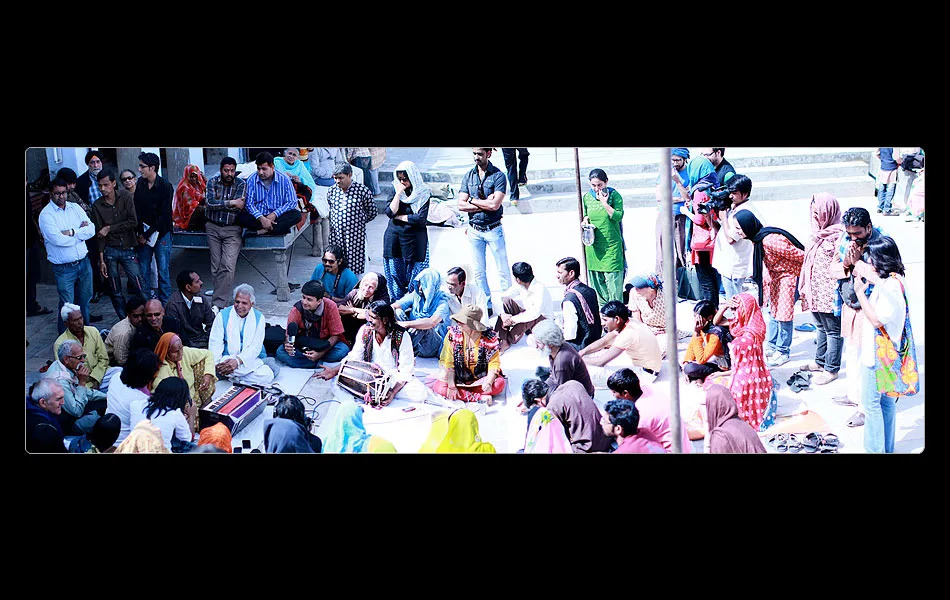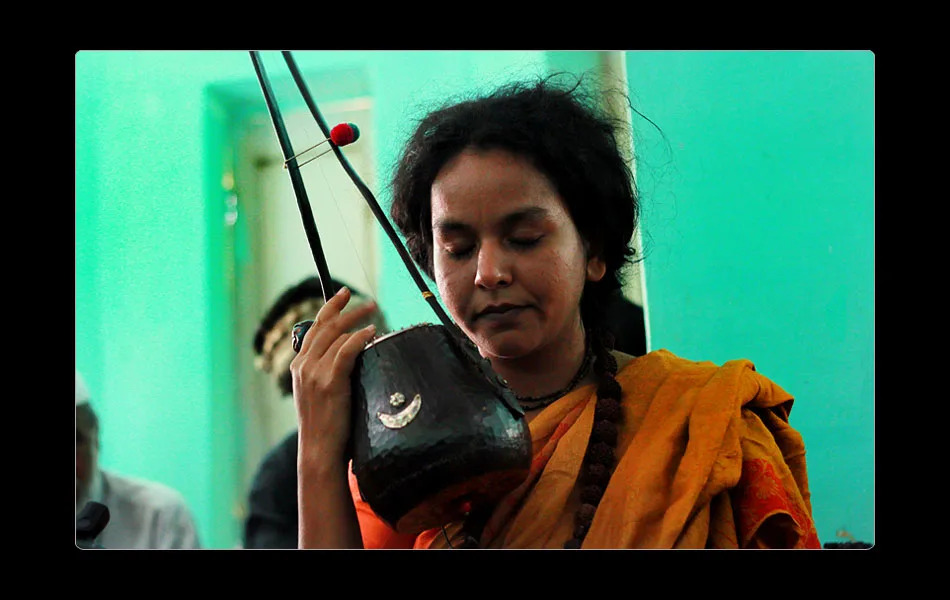
 1/10WITHIN/ WITHOUT The desert is an ideal place to slip within – when the eye has almost nothing external to grasp… And so, some of us carried out two journeys within this one. We traversed long, lonely desert roads – like this one – and treaded a bit on the dark, frightening path within, aided by the power of song. The marubhumi, or ‘difficult terrain’, or even, ‘land of death’, is an appropriate setting for a poetry that talks of dying to be born, to live, to be free. Like the figurative pearl-diver, the marajiva, diving into the consciousness ocean, to retrieve a forgotten jewel…
1/10WITHIN/ WITHOUT The desert is an ideal place to slip within – when the eye has almost nothing external to grasp… And so, some of us carried out two journeys within this one. We traversed long, lonely desert roads – like this one – and treaded a bit on the dark, frightening path within, aided by the power of song. The marubhumi, or ‘difficult terrain’, or even, ‘land of death’, is an appropriate setting for a poetry that talks of dying to be born, to live, to be free. Like the figurative pearl-diver, the marajiva, diving into the consciousness ocean, to retrieve a forgotten jewel…
 2/10SINGING/ LISTENING ‘Sur ko samre jo, use Hari milna mushkil naahin’. One who meditates on harmony discovers Hari easily, says Shafi Faqir, from the film Had Anhad, speaking to us directly of listening. Music and song are at the heart of the yatra – breaking into bhajans during bus-rides, bursting into dance of a sunlit morning, or the nightly concerts filled with the energy of sound. Yet each evening a Kabir-based documentary was screened to set the note for the music, to seek to draw attention to the poetry, the words themselves, challenges to forgetfulness, startling ruptures in the easy flow of melody.
2/10SINGING/ LISTENING ‘Sur ko samre jo, use Hari milna mushkil naahin’. One who meditates on harmony discovers Hari easily, says Shafi Faqir, from the film Had Anhad, speaking to us directly of listening. Music and song are at the heart of the yatra – breaking into bhajans during bus-rides, bursting into dance of a sunlit morning, or the nightly concerts filled with the energy of sound. Yet each evening a Kabir-based documentary was screened to set the note for the music, to seek to draw attention to the poetry, the words themselves, challenges to forgetfulness, startling ruptures in the easy flow of melody.
 3/10SLEEPING/ WAKING While sleeping piled together in a room was certainly a communal experience, it also meant impinging into each other’s spaces and snores. Sleep was at a premium. The chill of the nights penetrated into our rajais. Opportunity for shuteye came close to dawn, after long-held music. What did it mean, this all-night wake, a stubborn attention, this vigil over compositions of nothingness? … The wonder was being able to find the energy to go on, each day, after such short, stunted nights of sleep. Somehow the eight hours, or lack of, didn’t matter. Three did just as well. Well, almost.
3/10SLEEPING/ WAKING While sleeping piled together in a room was certainly a communal experience, it also meant impinging into each other’s spaces and snores. Sleep was at a premium. The chill of the nights penetrated into our rajais. Opportunity for shuteye came close to dawn, after long-held music. What did it mean, this all-night wake, a stubborn attention, this vigil over compositions of nothingness? … The wonder was being able to find the energy to go on, each day, after such short, stunted nights of sleep. Somehow the eight hours, or lack of, didn’t matter. Three did just as well. Well, almost.
 4/10YOUNG/ OLD Five-year old Arpita plays the manjiras on stage for Kaluram Bamaniya, her father and Malwi folk-singer, while behind her sits 65-year old Gavra Davi, who performed before them. The wayfarers on this journey came from all ages, backgrounds, and stations in life. There was a whole mandali from Malwa, steeped in Kabir and folk-music; young urban hippies, steeped in the ‘cool’; middle-aged questers for meaning; people of other nationalities, drawn by the music, struggling with the words. The singers themselves were diverse – from local performers to as far afield as Chennai and Bengal. A plurality strung together on a purpose.
4/10YOUNG/ OLD Five-year old Arpita plays the manjiras on stage for Kaluram Bamaniya, her father and Malwi folk-singer, while behind her sits 65-year old Gavra Davi, who performed before them. The wayfarers on this journey came from all ages, backgrounds, and stations in life. There was a whole mandali from Malwa, steeped in Kabir and folk-music; young urban hippies, steeped in the ‘cool’; middle-aged questers for meaning; people of other nationalities, drawn by the music, struggling with the words. The singers themselves were diverse – from local performers to as far afield as Chennai and Bengal. A plurality strung together on a purpose.
 5/10TECHNICAL/ HUMAN As much as the yatris, the machines needed charging. And there were an endless number of them – from cellphones to (just out of the frame) still cameras, video cameras, digital audio recorders, and other incomprehensible devices. One would have thought the paparazzi itself was here, chasing another Diana, as no performance or satsang was free of the technological overload. The mass of pictures uploaded on Facebook is a testimony; the hours of footage generated mindboggling. Even as one is grateful for the documentation which allows one to return and resample, a still, small voice wonders, what happened to simple listening?
5/10TECHNICAL/ HUMAN As much as the yatris, the machines needed charging. And there were an endless number of them – from cellphones to (just out of the frame) still cameras, video cameras, digital audio recorders, and other incomprehensible devices. One would have thought the paparazzi itself was here, chasing another Diana, as no performance or satsang was free of the technological overload. The mass of pictures uploaded on Facebook is a testimony; the hours of footage generated mindboggling. Even as one is grateful for the documentation which allows one to return and resample, a still, small voice wonders, what happened to simple listening?
 6/10WORDS, STONES, WOUNDS Three simple words – mind; sky; love. All three crucial to Kabir’s verse. You might say that when love strikes the mind, the sky shatters into pieces, like the stones scattered here. One of the yatris spoke of how her life went to pieces (in a good way) on reading the poetry. Kabir talks incessantly to the mann, this supple, subtle, uncontrollable organism that is neither heart nor mind, but something in between. Sky represents the element of space within, the place where one is essentially free, the gagan-mandal within the skull. And love… well, what can one say about love?
6/10WORDS, STONES, WOUNDS Three simple words – mind; sky; love. All three crucial to Kabir’s verse. You might say that when love strikes the mind, the sky shatters into pieces, like the stones scattered here. One of the yatris spoke of how her life went to pieces (in a good way) on reading the poetry. Kabir talks incessantly to the mann, this supple, subtle, uncontrollable organism that is neither heart nor mind, but something in between. Sky represents the element of space within, the place where one is essentially free, the gagan-mandal within the skull. And love… well, what can one say about love?
 7/10THE INFORMAL SESSIONS/ GAVRA DEVI If music and song were the heart of the yatra, the informal sessions between the yatris and individual singers were its soul. The explorations within this small satsang space lent it depth. Here Smriti’s lens captures a dramatic moment of focus around Gavra Devi, the local folk star. Gavra Devi shared her life-story, sang, explained the poetry, and regaled everybody with her devilish humour. Blind almost since birth, she lit up the gathering with the humility, honesty, humour and sheer warmth of her being. Of the bhajans, she said, “maine hriday mein dhar liye” (I established them in my heart).
7/10THE INFORMAL SESSIONS/ GAVRA DEVI If music and song were the heart of the yatra, the informal sessions between the yatris and individual singers were its soul. The explorations within this small satsang space lent it depth. Here Smriti’s lens captures a dramatic moment of focus around Gavra Devi, the local folk star. Gavra Devi shared her life-story, sang, explained the poetry, and regaled everybody with her devilish humour. Blind almost since birth, she lit up the gathering with the humility, honesty, humour and sheer warmth of her being. Of the bhajans, she said, “maine hriday mein dhar liye” (I established them in my heart).
 8/10PARVATHY BAUL Magic happened in the informal session on the sixth afternoon in the dhuni of Jageri. Parvathy was singing to us of surrender. And I saw surrender happen in action – Parvathy surrendered to the song; all of us to her singing. Faces changed expression; something dropped. She urged the mind (mann) to return to its nija niketana (its proper abode). Minds quietened. Silence after the song, within the song. … Parvathy spoke of how music descends into the very cells of the body in a state of surrender, how the body is able to receive it with a quietness of mind…
8/10PARVATHY BAUL Magic happened in the informal session on the sixth afternoon in the dhuni of Jageri. Parvathy was singing to us of surrender. And I saw surrender happen in action – Parvathy surrendered to the song; all of us to her singing. Faces changed expression; something dropped. She urged the mind (mann) to return to its nija niketana (its proper abode). Minds quietened. Silence after the song, within the song. … Parvathy spoke of how music descends into the very cells of the body in a state of surrender, how the body is able to receive it with a quietness of mind…
 9/10ABDULLAHBHAI On a warm, generous morning in the sunlit courtyard of an old haveli in Napasar, Abdullahbhai and Musa Para held us transfixed with Sufi songs, the story of creation, of separation (from the source), legends of the desert, and the inexorable fate of lovers… Abdullahbhai alternately transfixed us and moved us (and himself) to tears. His commentaries were even more riveting than the songs. Thus the love legend of Umar-Mahrui, where a local king abducts and holds captive a village girl, became a metaphor for the mind captivating the soul; for our trying to dominate what we do not understand.
9/10ABDULLAHBHAI On a warm, generous morning in the sunlit courtyard of an old haveli in Napasar, Abdullahbhai and Musa Para held us transfixed with Sufi songs, the story of creation, of separation (from the source), legends of the desert, and the inexorable fate of lovers… Abdullahbhai alternately transfixed us and moved us (and himself) to tears. His commentaries were even more riveting than the songs. Thus the love legend of Umar-Mahrui, where a local king abducts and holds captive a village girl, became a metaphor for the mind captivating the soul; for our trying to dominate what we do not understand.
 10/10Continue the Yatra here –
10/10Continue the Yatra here –
LET THE HEART-LOTUS RAIN, DRENCH THE BODY-SKY A poetic rendition of ‘Barse kamalyu, bheenje asmana’, the yatra motto, seen here on the banner behind Meerabai. The ulatbasi – or upside-down verse – is a stock of Kabir repertoires. You really have to enter the experience to see how it may all be upside-down, how the earth showers on the sky, the traveller walks but the path gets tired, the wet fence dries on the clothes, or how I existed even before my parents could be born. And so there welled up a flow in the desert, the dryness of the habitual drenched with unsuspected meaning for a brief while.
Editor’s note: Arundhati Subramaniam, the poetess-editor in her anthology Pilgrim’s India writes, ‘I’m aware that our experience of the sacred cannot exist anywhere outside of us. But I’m also given to travelling intermittently in quest of it.’ She sounds much like the author of our three part series, Vipul Rikhi. She also says, ‘Sacred journeys , those disruptive excursions are for those who want to cross thresholds. Its for those who mind the gap terribly.’ And the seekers have always been there. Pilgrimage and singing songs that celebrate the deepest spirit of life are very much native to the Indian psyche as a travel tradition. The open road has always been a beautiful excuse to find yourself or get lost or listen in. Join a retelling of 6 days of the Rajasthan Kabir Yatra, held from 23-29 February in and around Bikaner. Where over a hundred rural and urban folk mix on a journey, a discovery of mystic poet Kabir and themselves through song, dance, dialogue and travel. Buddhism often talks of the oneness of the form and the formless. What you can see and what you can sense. This journey too takes off at one level, with people listening and looking for mobile chargers to charge their communication with the outer world at their nightly village halt. As they travel together, there is another charge that walks in for some.Vipul Rikhi in this personal take shares his. A time-capsule look at the Rajasthan Kabir Yatra, through ten pictures and a thousand words. Ten moments described in precisely a hundred words each. Photos by Smriti Chanchani; text by Vipul Rikhi





